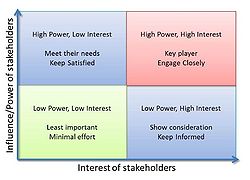COWI2020
Jamessunde (Talk | contribs) |
Jamessunde (Talk | contribs) m |
||
| Line 15: | Line 15: | ||
The Benefit Mapping Process is usually divided into three important stages; identification of benefits, execution of benefits and the sustain of benefits. This means that the process is not only something that needs to be implemented from the start, but carried out throughout the project and even after project implementation. | The Benefit Mapping Process is usually divided into three important stages; identification of benefits, execution of benefits and the sustain of benefits. This means that the process is not only something that needs to be implemented from the start, but carried out throughout the project and even after project implementation. | ||
| − | [[File:Benefits Map.png|thumb|Figure 2: Example of a Benefits Map Layout (click Figure for full size)]] | + | [[File:Benefits Map.png|thumb|right|Figure 2: Example of a Benefits Map Layout (click Figure for full size)]] |
Revision as of 08:47, 27 February 2020
Contents |
SWOT Analysis
te
Stakeholder Management
Stakeholders are organisations and persons who are actively involved in a project or affected by a project at some stage during its execution or completion. The ISO 21500 standard defines a stakeholder as "a person, group or organisation that has interests in, or can affect, be affected by, or perceive itself to be affected by, any aspect of the project". The purpose of identifying and classifying stakeholders is to simplify the process of identifying stakeholder concerns and thereby obtaining an easier tool for solving issues.The growing focus on stakeholder analysis is a clear reflection of the general tendency to recognise how stakeholders can influence decision-making processes.Based on the analysis of the stakeholders these can be mapped into overall categories, which allows the managers in an organisation to take action. The most commonly used stakeholder map is the power/interest matrix, seen in the figure to the right, which gives an easy and simple overview of what the different categories require with regards to what their needs are and how much they are able to influence the project.
Benefits Map
Benefits Map helps mapping possible benefits related to different projects and/or programs. This is to make it easier to pick the solutions giving the most or best benefits for the relevant stakeholders. Examples on benefits could be economical aspects or user friendliness. It is important to include key stakeholders and get their input in the benefit mapping process.
The Benefit Mapping Process is usually divided into three important stages; identification of benefits, execution of benefits and the sustain of benefits. This means that the process is not only something that needs to be implemented from the start, but carried out throughout the project and even after project implementation.
Earned Value Analysis
An Earned Value Analysis (EVA) used quantative analysis techniques and object performance indicators to measure both work progress and related cost to determine the overall efficiency of a respective activity, work package or project. To be able to do this, the analysis takes into account the scope of the project, the schedule of work and the work undertaken. This is to map the current situation, how much resources that has already been used and how much recourses that is necessary to finalize the project.
To successfully execute an EVA the following steps needs to be done:
1) Time-based schedule
2) Work Breakdown Structure
3) Cost Assessment
4) Progress measurement
5) Responsibility/ authority matrix
6) Monitoring and review process

